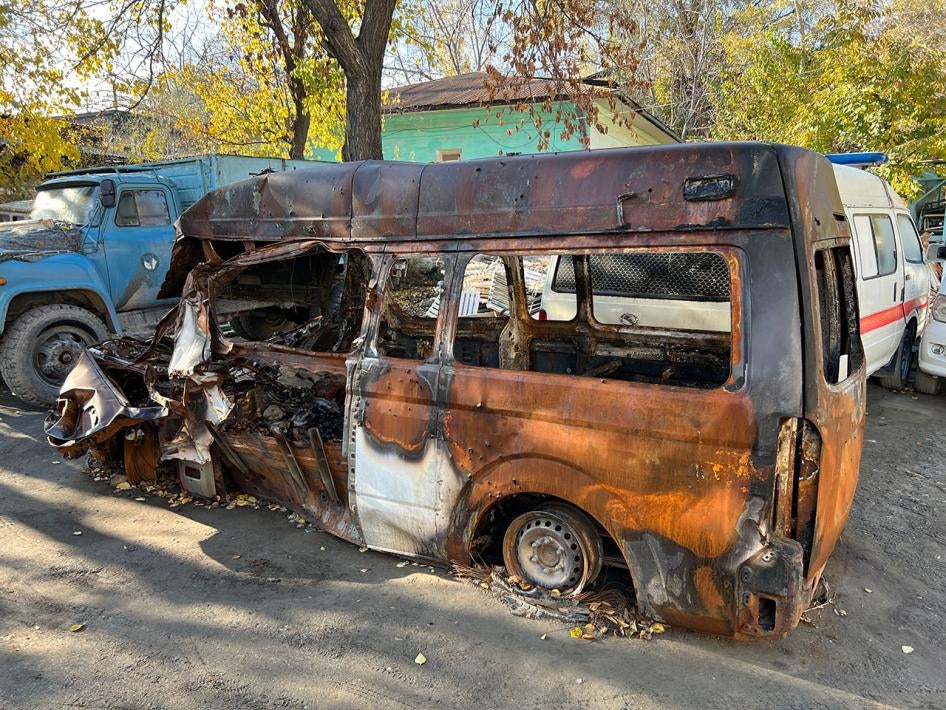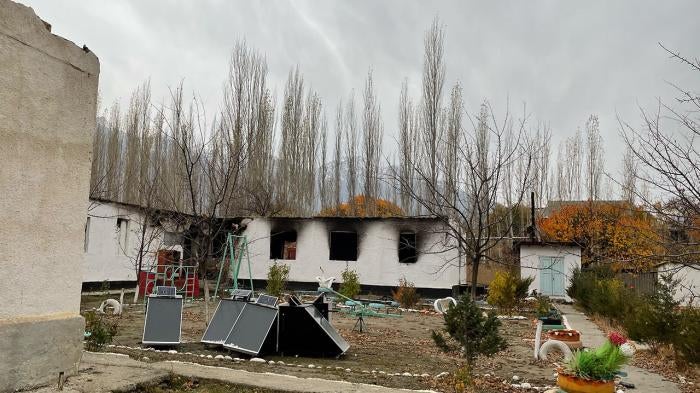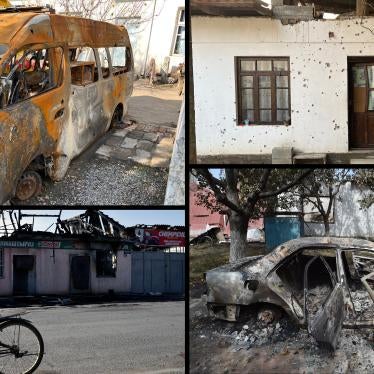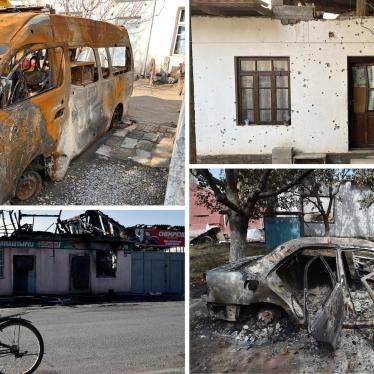Ahmadjon, a three-year-old boy from Tajikistan, died in a hospital on 16 September 2022 from two injuries to the abdomen sustained earlier that day. His family’s car had come under attack as they tried to flee fighting on the Kyrgyzstan border, most likely by Kyrgyz forces. “He didn’t even cry,” his mother told us. Two ambulances were also targeted.
The same day, Abboz, a 14-year-old Kyrgyz boy, saw his father, Suhrob Kenjebaev, killed in front of him, as the family’s car also came under fire. Abboz’s mother, who was wounded, told him to keep silent when Tajik soldiers surrounded the car. They eventually left the family for dead.
Ahmadjon and Abboz are among the scores of civilians whose lives have been ravaged by the callous and apparently unlawful actions of the forces of Kyrgyzstan and Tajikistan during their border conflict of September 2022.
The fighting was brief but intense, spanning four days over a roughly 110-kilometre stretch of a border that the two countries have never properly delineated since they gained independence in 1991 from the Soviet Union. The contested region contains critical choke points along rivers that provide strategic water resources to Batken – the district capital city on the Kyrgyzstan side – and to large swathes of irrigated farmland in Tajikistan.
Small-scale clashes have periodically broken out along the border since then, but the September 2022 conflict was the largest to date. An estimated 51 civilians may have been killed and up to 121 injured. Both sides killed and injured civilians in attacks that may amount to war crimes.
Human Rights Watch, where I work as a senior crisis and conflict researcher, investigated this internationally under-reported conflict and sought to understand the circumstances of the attacks that affected civilians. To prepare the report, our team interviewed 86 people, visited the sites of attacks on both sides of the border, reviewed photos, videos, medical records, and satellite imagery, and carried out 3D reconstructions and basic ballistic analysis. Our research and analysis, published on 2 May, was guided by international humanitarian law, which regulates the conduct of military operations to protect civilians and medical personnel from some of the worst consequences of war.
Human Rights Watch’s mandate is to establish the facts of how forces engage in conflict and whether they are following the internationally agreed-upon laws of war. These apply to all parties to a conflict, regardless of their role in initiating or escalating the fighting. While the laws of war allow military and other forces to attack their opponents and other military objectives, they impose on them two key requirements: they must distinguish at all times between military targets and civilian objects, and they must carry out attacks and deploy their forces in a manner that minimises harm to civilians.
By speaking to witnesses we established that on a single day of fighting, 16 September, forces from Kyrgyzstan and Tajikistan repeatedly failed to abide by these principles. We found that Tajik forces shot and killed at least eight civilians on that day, including older men with disabilities in their homes.
During their brief occupation of Kyrgyz villages, Tajik forces controlling the area failed to stop Tajik-speaking people in civilian clothes carrying out widespread looting and the burning of hundreds of civilian structures, including homes, medical facilities, kindergartens, schools, and official buildings, in what may have been an attempt to clear the area of its population. Under international humanitarian law, the deliberate killing of civilians, looting, and attacks on infrastructure not primarily used for military purposes are all war crimes.
Kyrgyz forces, meanwhile, attacked ambulances and cars being used by civilians. They also carried out a laser-guided bomb strike on a busy town square in the Tajik town of Ovchi Kal’acha, killing ten civilians and injuring at least 13 others, attacks that may also be war crimes.
The conflict ended as quickly as it had started. A ceasefire was agreed upon on 16 September. The two countries are involved in negotiations to delineate the border, but fighting could resume at any instant.
And for the victims and their families, life has changed forever. “My life was destroyed,” said Zoidbek Dadobekov, a 50-year-old construction worker from the Tajik town of Ovchi Kal’acha, who was severely injured in the laser-guided bomb strike and is now disabled, leaving his family destitute. “The future of my children, instead of studying, is migrant labour.”
One 53-year-old man from the Kyrgyz village of Bakai – almost entirely burned down when under the control of Tajik forces – told us he was thankful to be alive. Unable to guarantee the safety of his family in any future outbreak of conflict, he has decided not to return for now, staying instead at a nearby village. He is one of 4,000 Kyrgyz civilians who, as of January, remained displaced due to the events of September 2022.
What should happen now
The victims of unlawful attacks and their families deserve justice. Kyrgyzstan and Tajikistan should urgently investigate all alleged violations or abuses by their forces, impartially prosecute those responsible, and compensate victims. They should also provide appropriate training for their forces in international humanitarian law to ensure that such violations are not repeated in any future conflict. International partners have a role to play in helping both countries in these endeavours.
Kyrgyzstan and Tajikistan can also pledge to better safeguard civilians by endorsing the Safe Schools Declaration and the Political Declaration on the Use of Explosive Weapons in Populated Areas – two texts that dozens of governments around the world have already endorsed, showing their support for greater protection of students and civilian populations during conflict. By joining these other countries, Kyrgyzstan and Tajikistan would be committing to limiting the use of educational institutions for deploying their forces and reassessing their military practices to minimise the use of explosive weapons in populated areas, where weapons that affect wide areas are often indiscriminate.
Kyrgyzstan should also accede to the Rome Statute to become a member of the International Criminal Court, giving the court jurisdiction over crimes committed within Kyrgyzstan’s territory or by its forces.
Most civilians we spoke to on both sides yearn for peace. Many have fond memories of the time they were able to cross the border – currently closed – and interact with their neighbours. Some sold their apricot harvest across the border. Others would shop at the bazaar in the next town. Still others reminisced about attending weddings of neighbours on the other side.
Until they come to an agreement on their border dispute, and once they agree to demarcate, the two countries should ensure that their arrangements respect the rights of local communities, including their access to education, adequate housing, and water. Residents should be able to provide an adequate standard of living for themselves, including generating an income through legal cross-border economic activities, as necessary.
In the event of a land swap that deprives people of their homes and other property, the two countries should ensure that anyone deprived of property is compensated in line with international law.
An important sign of progress came this week when negotiators from both governments agreed to refrain from using armed drones in their border areas. We hope the two countries will go further and follow other recommendations to protect civilians. The people who live on the border deserve to see the end of this cycle of conflict and abuse, so they can live safe and fulfilling lives.











